GrainPro GRAINSAFE BAG-1.0 User manual

GRAINPRO® GRAINSAFE™ BAG-1.0
INSTRUCTION MANUAL
MA4010RLR1009-6

2/18
GrainPro® GrainSafe™ Bag-1.0 Instruction Manual
MA4010RLR1009-6
GrainPro Inc.
4410A Connecticut Avenue. NW, #163, Washington, DC 20008
Tel: +1 202-921-6700
Email: sales@grainpro.com
GrainPro® Philippines, Inc.
Lot 46 Efficiency Avenue, Subic Bay Gateway Park I, Subic Bay Freeport Zone 2222 Philippines
Phone: +63 47 252 7884 Fax: +63 47 252 7885 Website: www.grainpro.com
Email: salesasia@grainpro.com
GrainPro Kenya
Space Apartments, GF Shio A2 Maimahui Rd. Nairobi West, Kenya
Tel: +254 737 177 767
Fax: +254 710 933 717
Email: sales@grainpro.com
GrainPro Mexico, S de RL de CV
Ctoo. Garona No. 903, Sección Tres, Col. Amberes, 37237,
León, Gto. Mexico
Mobile: +52 1 (477) 392 0851
Email: guillermo@grainpro.com
GrainPro Costa Rica S.R.L.
Residencial Valle del Sol, Calle Lajas, Casa #27 Alto de las Palomas,
Santa Ana, San José, Costa Rica
Tel: +506 2282 9129
Email: infogpcr@grainpro.com
GrainPro India Post-Harvest Technology Pvt. Ltd.
Office Number 18A109, WeWork Berger Tower 18th Floor,
C-001/A2, Sector 16-B, Noida, INDIA –201301
Landline: +91 120 515 0017
Customer Service : +91 960 292 0202
Email: praveen.gupta@grainpro.com
GrainPro® Inc., 1401 K Street NW, Suite 502, Washington D.C. 20005 USA
Copyright 2019 GrainPro®, Inc.

3/18
GrainPro® GrainSafe™ Bag-1.0 Instruction Manual
MA4010RLR1009-6
TABLE OF CONTENTS
1. INTRODUCTION ........................................................................................................................... 4
2. CHECKLIST.................................................................................................................................... 5
3. COMPONENTS ............................................................................................................................. 6
4. SPECIFICATIONS........................................................................................................................... 6
5. WARNINGS………………………………………………………………………………………………………………………………7
6. RECOMMENDED MAXIMUM MOISTURE CONTENT FOR SAFE STORAGE…………………………………7
7. INSTALLATION.............................................................................................................................. 7
Site selection .......................................................................................................................... 8
Termite Control………………………………………………………………………………………………………………….8
Rodent Control………………………………………………………………………………………………………………….9
Loading ................................................................................................................................. 10
Zipping.................................................................................................................................. 11
Installation of rodent guard (RG) ......................................................................................... 12
Outdoor installation ............................................................................................................. 13
Monitoring the oxygen level ................................................................................................ 13
Dismantling........................................................................................................................... 14
8. Preventing Condensation………………………………………………………………………………………………………14
Why does condensation occur ............................................................................................. 14
Moisture content (MC) requirement for safe storage ......................................................... 14
9. Maintenance and Care………………………………………………………………………………………………………….15
Regular Examination ............................................................................................................ 15
Repairing punctures and other damages ............................................................................. 15
Recommended weekly monitoring ...................................................................................... 15
Cleaning................................................................................................................................ 16
Safekeeping .......................................................................................................................... 16
Prohibited item not allowed to ship..................................................................................... 16
Recycling............................................................................................................................... 16
10. FREQUENTLY ASKED QUESTIONS AND ANSWERS………………………………………………………………….16
11. WARRANTY CLAUSE………………………………………………………………………………………………………………18

4/18
GrainPro® GrainSafe™ Bag-1.0 Instruction Manual
MA4010RLR1009-6
1. INTRODUCTION
The GrainPro® GrainSafe BagTM - 1.0 is a portable bagged storage for grain and seed, normally
set-up at ground levels such as on concrete pavement or on a pallet. The use of a platform is
also an option. It safely stores any dry agricultural commodities like maize, wheat, paddy,
coffee, and others at or below safe moisture content. It works under the principle of
hermeticity (airtight). It is made from a specially designed food grade, Ultra-Hermetic material,
and zipper system. Insects’ natural breathing process depletes the available oxygen and
replaces it with carbon dioxide. This conversion typically occurs within 10 days of storage. The
heavier the infestation, the more rapid is the kill. The liner of the GrainSafe BagTM is a UV-
resistant, waterproof, low permeability and is resistant to rodent penetration when properly
installed.
1.1. FEATURES:
1.1.1. The quality of commodities is preserved without the use of chemicals.
1.1.2. It maintains its effectiveness under rainfall and wind conditions, evenmonsoons.
1.1.3. It is designed to be used inside or outdoor provided that the shade or cover is installed.
1.1.4. It can be set-up on a platform with anti-rodent protection to prevent rodent attack.
1.1.5. It is designed to store commodities up to one ton capacity.
1.1.6. A green technology for organic product storage (certified safe for organic grain storage-
secondary packaging)
1.2. PRODUCT GUARANTEE:
1.2.1. In accordance with the terms and conditions herewith, GrainPro®Inc., guarantees the quality of
this product per its written warranty provided it is used according to the instructions in this
manual.
1.2.2. Please read and understand the manual thoroughly before using the GS Bag-1.0TM.
1.3. COMMENTS, COMPLAINTS, AND/OR CLARIFICATIONS:
1.3.1. Please contact customercare@grainpro.com.
1.3.2. All queries will be answered by our team of post-harvest solutions experts.

5/18
GrainPro® GrainSafe™ Bag-1.0 Instruction Manual
MA4010RLR1009-6
2. CHECKLIST
Please inspect your GrainPro® GS Bag-1.0TM to ensure that the package includes the following items:
PART NAME DESCRIPTION IMAGE
2.1. CARRY BAG 2.1.1. GrainSafe bag.
2.1.2. Small parts.
2.1.3. Instruction manual.
2.2. ZIPPER PULL 2.2.1. For zipper sealing.
Two (2) pieces (left
and right)
2.3. PATCHING 2.3.1. White-colored PVC
MATERIAL roll for patching
the holes and
damaged.
One (1) piece
(30cm x 1.5m)
2.4. PETACKS BOND 2.4.1. For patching PVC
GLUE materials.
One (1) tube
2.5. RODENT GUARD 2.5.1. For platform post
to prevent rodent
access when storing
the empty GS Bag-
1.0TM.
Four (4) pieces per
pack

6/18
GrainPro® GrainSafe™ Bag-1.0 Instruction Manual
MA4010RLR1009-6
2.6. INSTRUCTION
MANUAL
2.6.1. Installation
instructions.
2.6.2. Maintenance
instructions.
2.6.3. Frequently asked
questions and
answers.
2.6.4. Warranty clause.
3. COMPONENTS
4. SPECIFICATIONS
PARAMETER
STANDARD
Material
Flexible Polyvinyl Chloride
(PVC)
Thickness, mm (inch)
0.83(0.033) ±7%
Color
White
Material weight, g/m2
1,050
Oxygen Transmission Rate (OTR), cm3/m3/day@ 0.1MPa
500

7/18
GrainPro® GrainSafe™ Bag-1.0 Instruction Manual
MA4010RLR1009-6
Water Vapor Transmission Rate (WVTR), g/m3/day
9
Product Life, years
15
Warranty, years
5
Sealing Mechanism
PVC Hermetic Zipper
Capacity, kg(lbs.) Based on wheat
1000 (2205)
Dimensions, (A x B x C), cm (inch)
120 x 120 x 200(47 x47 x 79)
Product Weight, kg (lbs)
12.5 (28)
Packed Dimensions, cm. (inch)
100 x 40 x 10 (39 x 16 x 4)
Packed volume, m3(ft3)
0.04 (1.4)
5.
WARNING!
5.1 Do not put fresh produce or commodities with high moisture content inside the GS Bag 1.0TM.
5.2 Do not wear shoes with spikes that might cause damage to the GS Bag 1.0 TM.
5.3 Do not directly install the GS Bag 1.0 TM without clearing away debris and other foreign
materials.
5.4 Do not smoke during installation, as cigarette butts might burn and damage the GS Bag 1.0TM.
5.5 Do not put the GS Bag 1.0TM on top of a wooden pallet or equivalent to prevent puncture by
sharp edges and nails.
5.6 Do not keep the GS Bag 1.0 TM unclean. Refer to 7.4 for proper safekeeping.
5.7 Do not allow loading vehicles (i.e., forklift/trucks) to run over the GS Bag 1.0 TM as this will cause
damage to the PVC material.
6.
RECOMMENDED MAXIMUM MOISTURE CONTENT FOR SAFE STORAGE (WET BASIS)
Barley
12%
Black Pepper
10%
Cashew nuts
8%
Chia seeds
7%
Chickpeas
12%
Cocoa beans
7%
Coffee beans
12%
Cotton seed
10%
Cowpea
12%
Maize
13.5%
Millet
12%
Mung bean
12%
Oats
12%
Paddy
13.5%
Paddy, rice bran
11%
Peanuts, shelled
7%
Red Chili Pepper
8-10%
Rice, milled
12%
Rye
12%
Sesame
5.5%
Sorghum
12%
Soybean
12%
Sunflower
7%
Wheat
13%

8/18
GrainPro® GrainSafe™ Bag-1.0 Instruction Manual
MA4010RLR1009-6
You may also contact us through customercare@grainpro.com for more information or for commodities
that are not on the list.
7.2.TERMITE CONTROL
Overview of Termite
a. The two most common types
of termites are "dry wood"
and "ground," or
subterranean termites.
b. Termites need moisture to
survive and will die if
exposed to sunlight or open
air for more than a few
minutes. Their tunnels
protect them from these
elements.
c. High moisture areas like basements and crawl spaces are very attractive to
termites and can serve as starting points for an infestation.
Description (Subterranean Termite)
a. Food and moisture:
▪Need a great deal of moisture from soil or damp wood. Cellulose (from wood)
is part of their diet.
b. Habitat:
▪Usually, they live in the soil but can be above ground if enough moisture is
present. They have large colonies.
c. Evidence of activity:
▪Protective mud tubes ascending from the ground to the structure or protruding
from walls, etc.
7.
SITE SELECTION
5.8 In selecting a site, look for a concrete or
asphalt platform.
a. A smooth area away from standing or
running water.
b. Prepare the site by clearing away all
sharp objects (stones, broken glasses,
nails, etc.) that may puncture the GS
Bag-1.0TM.
c. An inspection path around the
perimeter (at least 75cm).
If ground will be used as a flooring, put a
layer (5cm) of fine sand (or any equivalent)
on top of the soil as a ground foundation
to prevent rats and termites from
damaging the bottom of the GS Bag-1.0TM.

9/18
GrainPro® GrainSafe™ Bag-1.0 Instruction Manual
MA4010RLR1009-6
d. Prevention:
▪Treat the soil before construction using termiticide.
▪For more information search for Chemical Soil Treatment.
▪A termite bait station monitoring system to monitor termite activity and bait
placements after detection.
▪Regular inspections.
e. Control Measures:
▪With current activity use a baiting program or a termite barrier treatment.
Termite Treatments
a. The traditional method of controlling subterranean termites is to apply a liquid
pesticide, known as a termiticide, to the soil. This chemical treatment relied on the
application of a chemical barrier around and beneath the structure designed to
block all possible routes of termite entry. Any termites attempting to penetrate
through the treated soil were either killed or repelled.
b. There are several different insecticides currently used by pest control operators
for termite soil treatments. All of them are safe and effective when used per label
directions. The insecticides remain effective in the soil for approximately 5 to 10
years.
c. Effective termite treatments require a great volume of termiticide.
7.3.RODENT CONTROL
Prevention:
a. Eliminate unnecessary folds on the sidewalls of the GS Bag 1.0TM when installed.
b. Remove all potential sources of food from the premises, such as scattered grains, etc.
c. Remove all trash and debris around the GS Bag 1.0TM as it may use a shelter of rodents.
d. Keep trash cans closed with tightly fitted lids and should be away from the GS Bag
1.0TM.
e. Trim trees, bushes, and vines at least 1.5 meters away as it may be used by rodents to
crawl on top of the GS Bag 1.0TM.
Procedure in installing wire mesh: (Optional)
For ground installations and for areas with high risk of rodents’ attack, it is highly recommended
to use wire mesh not larger than ¼ inch to exclude mice.
a. To install the wire mesh, prepare the selected site by clearing away all sharp objects
(stones, broken glass, nails, etc.) that may puncture the GS Bag 1.0TM. (Refer to 7.1.2)
b. Cut the wire mesh at least 50 centimeters wider than the bottom of the GS Bag 1.0TM.
c. Spread the wire mesh before the fine
sand and equivalent as a recommended
protection of the GS Bag 1.0TM.
d. Then, follow the standard procedure on
how to install GS Bag 1.0TM.
Procedure for installing GI sheet: (Optional)
a. Install the GI sheet 1 meter away from the
sidewall of the GS Bag 1.0TM.
b. Make sure that the GI sheet has wooden
posts or any equivalent that can
withstand the wind.
Requirement for GI sheet:

10/18
GrainPro® GrainSafe™ Bag-1.0 Instruction Manual
MA4010RLR1009-6
8.1.2.Unfold the bag and lay it out
on the
prepared site. Place the empty bag on the
prepared area with the bottom stretched.
8.1.1.Check the moisture content (MC)
of the
commodity to ensure commodity will be
stored at safe MC.
8.1. LOADING
a. Length should be 1 meter away from the sidewall of the GS Bag 1.0.
b. Height is at least 80 centimeters.
c. Gauge or thickness is at least 16.
8. INSTALLATION
8.1.3 Loading procedure (requires at least two
people):
a. One person fills the GS Bag-1.0TM.
b. The second person keeps the bag openand
maintains proper arrangement of sacks.
c. Load the bagged commodities throughthe
open zipper while stretching the bag to
prevent crumpling.
8.1.4. Platform positioning (if necessary):
a. Wood, bamboo, bricks, or concrete canbe
used to construct the platform. Ensure
that the platform is sturdy and stable
enough to take the load of the GS Bag-1.0
with the commodity. Added protection
such as mat, old sacks or cardboard is also
recommended

11/18
GrainPro® GrainSafe™ Bag-1.0 Instruction Manual
MA4010RLR1009-6
8.1.5. Required capacity:
a. Keep the sacks stable by loading the
succeeding layers in a crisscrossmanner.
b. Continue piling until the desired GS Bag-
1.0 height is reached.
8.2. ZIPPING
8.2.1. Preparing to zip:
a. After the GS Bag-1.0 has been filled to
its recommended capacity, position the
hermetic zipper flat on top of the stack.
b. Make sure that the zipper tracks are
free from dirt so that the zipping can be
done properly.
8.2.2. Using the zipper pull:
a. Starting from the end of the zipper,
place the smaller black running wheel
inside the liner facing upward to lock
the bottom liner zipper track.
b. Place the larger wheel outside the liner
facing upward to lock the top liner
zipper track.
c. Rotate the zipper pull’s plastic handle
180° toward its pulling loop, forcing the
tongues and grooves of the two zipper
tracks together.
d. Slide the zipper pull to the other entire
length of the zipper track.

12/18
GrainPro® GrainSafe™ Bag-1.0 Instruction Manual
MA4010RLR1009-6
e. To make zipping easier, two persons are
required. One will do the zipping and the
other will hold the other end steadily
making both sections of the zipper in a
straight line to avoid zagging.
8.2.3. Completing the zipper process:
a. Align the marks (“triangles”) printed on
both tracks located above and below
zipper.
b. If a pair does not match, slide back the
zipper by pulling the top and bottom part
in an opposite direction until the marks
meet.
8.2.4. Removing the zipper pull:
c. When you have zipped the entirelength of
the zipper track, take the zipper pull off
the track by rotating the plastic handle
180° away from the zipper pull loop.
d. Close the last few centimeters of the
zipper track by manually pressing to latch
the zipper’s tongue and groove.
8.2.5. Ensuring a complete hermetic closure:
e. Make sure to close the zipper correctlyto
maintain its gas-tightness.
8.3. INSTALLATION OF RODENT GUARD (RG)
8.3.1. For protection against rodent attacks (one set
contains 4 pieces):
a) One set can be installed on any platformlegs
with leg perimeter (round or square) of 22
cm (9'') to 44 cm (17'').
b) If the diameter of the leg is smaller, the
rodent guard can be cut to fit the legs.

13/18
GrainPro® GrainSafe™ Bag-1.0 Instruction Manual
MA4010RLR1009-6
8.3.2. Fold the rodent guard's teeth upwards against
the sides of the leg to keep it fromslipping.
8.3.3. Make sure to overlap the sides at least one
inch.
8.3.4. Lock the overlap using staple wire, cable
wire, or any fastener.
8.4. OUTDOOR INSTALLATION
8.4.1. The GS Bag-1.0TM must be protected from the
direct sunlight by installing the shade/cover
such as a roof cone from any available
insulating material (straw,reflective material,
matting) that are commonly used to protect
the traditional local storage facilities.
8.5. MONITORING THE OXYGEN LEVEL
8.5.1. Use of an oxygen analyzer:
a. During the first 15 days of installation,
oxygen level must be checked daily using
the oxygen analyzer.

14/18
GrainPro® GrainSafe™ Bag-1.0 Instruction Manual
MA4010RLR1009-6
b. Succeeding monitoring should be done
twice a week. Normally, oxygen levels
should drop 1-2% per day to a level less
than 3% (though lower levels have been
observed as well). Oxygen levels go up by
a few percent but must not exceed 7%.
Except for coffee beans and seeds, in this
situation, the sealing is probably
compromised, and the commodity may
not be adequately protected.
c. When the oxygen does not drop for 3 to 7
days or increase in carbon dioxide is not
observed, check for pinholes or damage in
the Cocoon sections.
8.6. DISMANTLING
8.6.1. The commodity will only be unloadedat
the end of the storage.
9. PREVENTING CONDENSATION
9.1. WHY DOES CONDENSATION OCCUR?
9.1.2. Condensation is caused by temperature changes i.e., hot weather by day and cool at night or
sudden rains in a hot sunny day. When air collides with a cool surface at dew point
temperature the vapor in the air condenses on the surface. Air movement insidethe GS Bag-
1.0TM follow the natural forces i.e., in convection currents hot air rise and coolair sinks (except
for the phenomenon called inversion). Hence, when warm air inside the GS Bag-1.0TM rises
and hits the cool GS Bag-1.0TM top cover at dew point temperature, condensation occurs.
9.1.3. Therefore, avoiding trapped warm air inside the GS Bag-1.0TM can prevent condensationat the
top layer. This is the role of the roof cone (shade/cover). It prevents heating of air inside the
GS Bag-1.0TM by repelling solar radiation.
9.2. MOISTURE CONTENT (MC) REQUIREMENT FOR SAFE STORAGE
9.2.1. Commodities should be dried before storage to at least 12% MC for sorghum, 9-10%millet,
12-14% for paddy, and maize, and 13% for wheat.
9.2.2. When the commodity is properly dried, there is virtually no “available water” that the
microorganisms can use for growth and development.
9.2.3. This condition can be maintained by avoiding ambient air (with variable moisture
content) to be in contact with the dried product using the hermetic storage.
technology.

15/18
GrainPro® GrainSafe™ Bag-1.0 Instruction Manual
MA4010RLR1009-6
10. MAINTENANCE AND CARE
10.1. REGULAR EXAMINATION
10.1.1.Check the zipper track for any small opening/s and push the opened track section by hand.
10.1.2.Check GS Bag-1.0TM for punctures or cuts (do not forget to check near the bottom,
particularly for rodent damage). If there are any, repair them with the patch kit as described
below.
10.1.3.Avoid low overhanging structure or tree branches that would allow rodents to jump ontop
of the GS BAG-1.0TM.
10.1.4.During the rainy season, the upper surface of the GS BAG-1.0TM. should be regularly
inspected for water accumulation and damages that would permit water to seep into the GS
BAG-1.0TM. The content is not adequately protected if the GS BAG-1.0TM is not completely
sealed.
10.1.5.Carbon dioxide level does not increase:
a. Check for a possible opening of zippers, and holes/punctures/cuts.
b. Seal/repair it immediately.
c. Monitor the carbon dioxide level using the analyzer through the gas sampling port.
10.2. REPAIRING PUNCTURES AND OTHER DAMAGES
10.2.1.Use the patching material and adhesive
found in the repair kit:
a. Clean the area to be patched with adamp
cloth or organic solvent.
b. Apply a glue (150-200g) on both surface
with a brush or equivalent.
c. Let it dry for 5-10 minutes and stick and
apply sufficient pressure.
10.2.2. Protective maintenance
a. Check the patched PVC occasionally and replace or re-patch if necessary.
10.3. RECOMMENDED WEEKLY MONITORING
10.3.1.Check whether the hermetic zipper has not opened anywhere along the length. If openings
are observed, press the tracks together by hand.
10.3.2.Inspect the liner and make sure that there are no punctures or tears (or rodent damages). If
there are any, repair them immediately.
10.3.3.Check the top of the GS BAG-1.0TM to make sure that there is no standing water (especially
during the rainy season). If there is any, it must be removed by hand or tools that do not risk
puncturing the liner.
10.3.4.Make sure that there is no low overhanging structure or tree branch, which would allow
rodents to jump on top of the GS BAG-1.0TM.

16/18
GrainPro® GrainSafe™ Bag-1.0 Instruction Manual
MA4010RLR1009-6
10.4. CLEANING
10.4.1.If necessary, use soap and water.
10.4.2.Dry under the sun.
10.5. SAFEKEEPING
10.5.1.The empty GS Bag-1.0TM should be stored away from heat or direct sunlight and away from
rodents.
10.5.2.Do not place heavy objects on top of the stored GS Bag-1.0TM to prevent damage or
deformity.
10.6. PROHIBITED ITEM NOT ALLOWED TO SHIP
10.6.1.The Glue (for patching PVC materials) is not allowed to be shipped in air cargo. Thisitem
will be removed from the package.
10.6.2.The client is advised to purchase the local equivalent.
10.7. RECYCLING
GrainPro GS Bag 1.0TM is made of PVC.
10.7.1. The products can be delivered to the nearest recycling facilities in the area.
10.7.2. Plastic #3 –PVC (Vinyl) can be recycled into paneling, flooring, speed bumps, decks,or
roadway gutters.
11. FREQUENTLY ASKED QUESTIONS AND ANSWERS
11.1. DO I NEED TO PUMP THE AIR OUT OF THE GS BAG-1.0TM OR MODIFY THE AIR INSIDE THE GS
BAG-1.0TM, FOR EXAMPLE WITH CARBON DIOXIDE?
▪No, you do not need to pump out or change the atmosphere in any way. The insects own
natural metabolic functions use up all the available oxygen and replace it with carbon
dioxide. Atmospheres modified with carbon dioxide or vacuum can enhance the quality of
stored product, and reduce the insect kill time, but are not required to eliminate insect
infestations.
11.2. IF THE STORED COMMODITY IS ALREADY INSECT INFESTED, DO I NEED TO FUMIGATE ITOR
OTHERWISE KILL THE INFESTATION BEFORE STORING IT?
▪No, you do not need to fumigate or kill the infesting pests before storing the food. The
insects will die naturally in a matter of days. The greater the infestation the fasterthe kill.
11.3. IS THERE ANYTHING YOU DO NOT RECOMMEND THE GS BAG-1.0TM FOR?
▪Yes, the GS Bag-1.0TM is not recommended for storing fresh fruits, vegetables, or medicines.

17/18
GrainPro® GrainSafe™ Bag-1.0 Instruction Manual
MA4010RLR1009-6
11.4. CAN YOU ADD OR TAKE OUT ITEMS ONCE THE GS BAG-1.0TM IS FILLED AND CLOSED?
▪Yes, you may add or take out items. If the added items are infested, the insects willnaturally
modify the internal atmosphere again and die off.
11.5. DO I NEED TO FILL THE GS BAG-1.0TM ENTIRELY FOR IT TO WORK?
▪GS Bag-1.0TM is designed to work effectively at any given load. Load your GS Bag-1.0TM to its
optimum dimensions to ensure full protection from insect infestations.
11.6. SHOULD THE GS BAG-1.0TM BE ONLY ERECTED INDOORS?
▪No. GS BAG-1.0TM is designed for outdoor use also under all types of climatic conditions.
11.7. WILL A PUNCTURE NEGATE THE BENEFITS OF HERMETICITY OF THE GS BAG-1.0TM?
▪No, although a hole/tear will allow oxygen to seep into the GS Bag-1.0TM and will cultivate
live insects around the puncture/hole. Tight stacking of the stored commodity tends to
prevent spreading of infestation inside the GS Bag-1.0TM. We recommend immediate repair
of all punctures or tears.
11.8. HOW DRY MUST THE GRAIN BE TO STORE IT SAFELY IN THE GS BAG-1.0TM?
▪The GS BAG-1.0TM works best with grains at or below critical moisture content.
11.9. CAN T HE RODENTS CHEW RIGHT THROUGH THE PVC MATERIAL WHEN THE GS BAG-1.0TM IS
ERECTED?
▪Yes, but only if the sides are not taut enough. Rodents can only gnaw on the smooth,slippery
surface of a GS Bag-1.0TM if the sides are not properly stretched or rodents drops down from
any object hanging over the GS Bag-1.0TM such as a low–hanging branch of a tree. In areas
with high rodent activity, we recommend that a GS Bag-1.0TM be protected using anti-
rodent barriers.
11.10.CAN AGRICULTURAL COMMODITIES OTHER THAN GRAIN BE STORED IN A GS BAG-1.0TM?
▪Yes, most dry agricultural commodities such as seeds, pulses, beans, coffee, cocoa, some
dried fruits, and even dried chilies can be safely stored. When in doubt, ask GrainPro.

18/18
GrainPro® GrainSafe™ Bag-1.0 Instruction Manual
MA4010RLR1009-6
12. WARRANTY CLAUSE
GrainPro® hereby warrants that product sold by it to Buyer shall be free of defects in workmanship
and materials, for a period as follows, starting from the date of shipment (B/L): Five years for the
GrainSafe Bag-1.0™ (GS Bag-1.0™) liner and zipper. One year for all other parts.
The warranty liability is limited to replacement of defective products during the warranty period at
GrainPro’s plant in accordance with the provisions specifically and expressly set forth herein.
The Buyer will pay for Products which need to be replaced under warranty, a percentage of the full list
price according to the ratio between the period, which has passed until replacement, and the full
warranty period.
The Buyer shall bear shipping costs for shipment of defective Products to GrainPro, and GrainPro shall
bear shipping costs of returning good Products to Buyer.
The Warranty does not cover the cost of any services, work, or materials required for the replacement
of defective Products with good Products at the site of installation.
GrainPro shall have no obligation under the warranty to replace defective Products or parts thereof if
the defect is a result of any of the following: normal wear and tear; damages occurring after delivery,
accidents, acts of God, or catastrophes, fault or negligence, or improper storage installation,
maintenance of the Products.
Replacement costs and shipping charges for Products found not to be under warranty as specified
above would be paid in full by the Buyer before new/refurbished Products are shipped to.
Notwithstanding the above, if the Products include main parts or sub-assemblies purchased by
GrainPro from other vendors ("Additional Equipment"), then the period and terms of warranty for
Additional Equipment are limited to the period and terms offered by the vendors of such
equipment.
The Buyer agrees that the warranty liabilities of GrainPro shall be and are limited to the express
foregoing terms: THE EXPRESS WARRANTIES AND OBLIGATIONS SET FORTH ABOVE, ARE AND SHALL BE
IN LIEU OF ALL OTHER WARRANTIES AND OBLIGATIONS OF GRAINPRO, EXPRESSED OR IMPLIED. EXCEPT
TO THE EXTENT HEREIN PROVIDED, GRAINPRO DOES NOT MAKE AND SHALL NOT BE DEEMED TO MAKE
ANY WARRANTY WHATSOEVER TO THE, TO ANY END USER OR TO ANY OTHER PERSON OR PARTY,
INCLUDING, WITHOUT LIMITATION, ANY WARRANTY OF MERCHANTABILITY OR OF FITNESS FOR ANY
PARTICULAR USE OR PURPOSE. GRAINPRO SHALL NOT BE LIABLE FOR ANY LOSS OF USE, SALES OR
PROFIT OR FOR ANY INDIRECT, CONSEQUENTIAL OR INCIDENTAL DAMAGES CAUSED BY OR SUFFERED
AS A RESULT OF THE SALE OR USE OF THE PRODUCTS.
For further information and clarifications, visit our website at www.grainpro.com; email our Customer
Table of contents
Other GrainPro Farm Equipment manuals
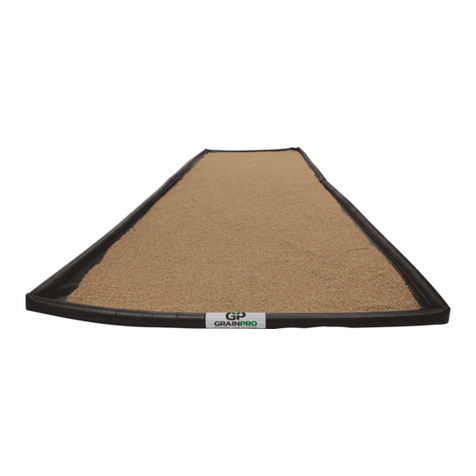
GrainPro
GrainPro COLLAPSIBLE DRYER CASE II User manual
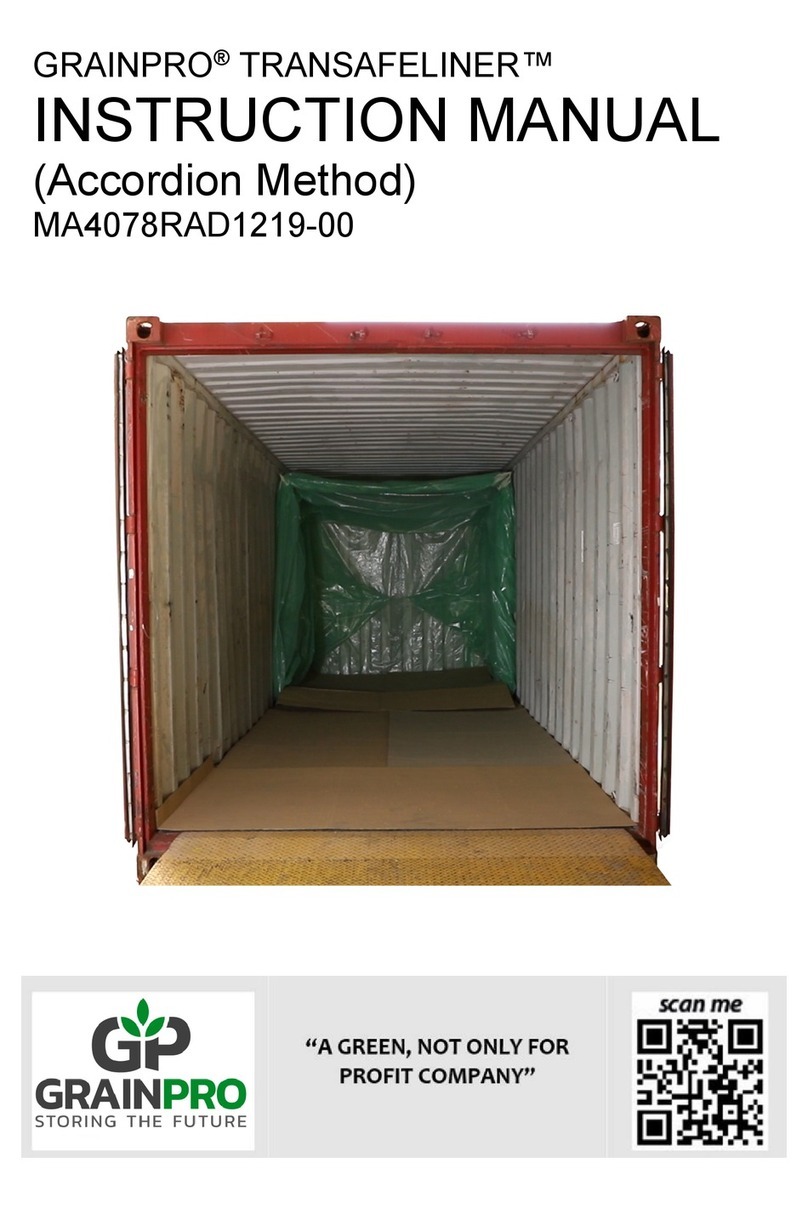
GrainPro
GrainPro TRANSAFELINER User manual
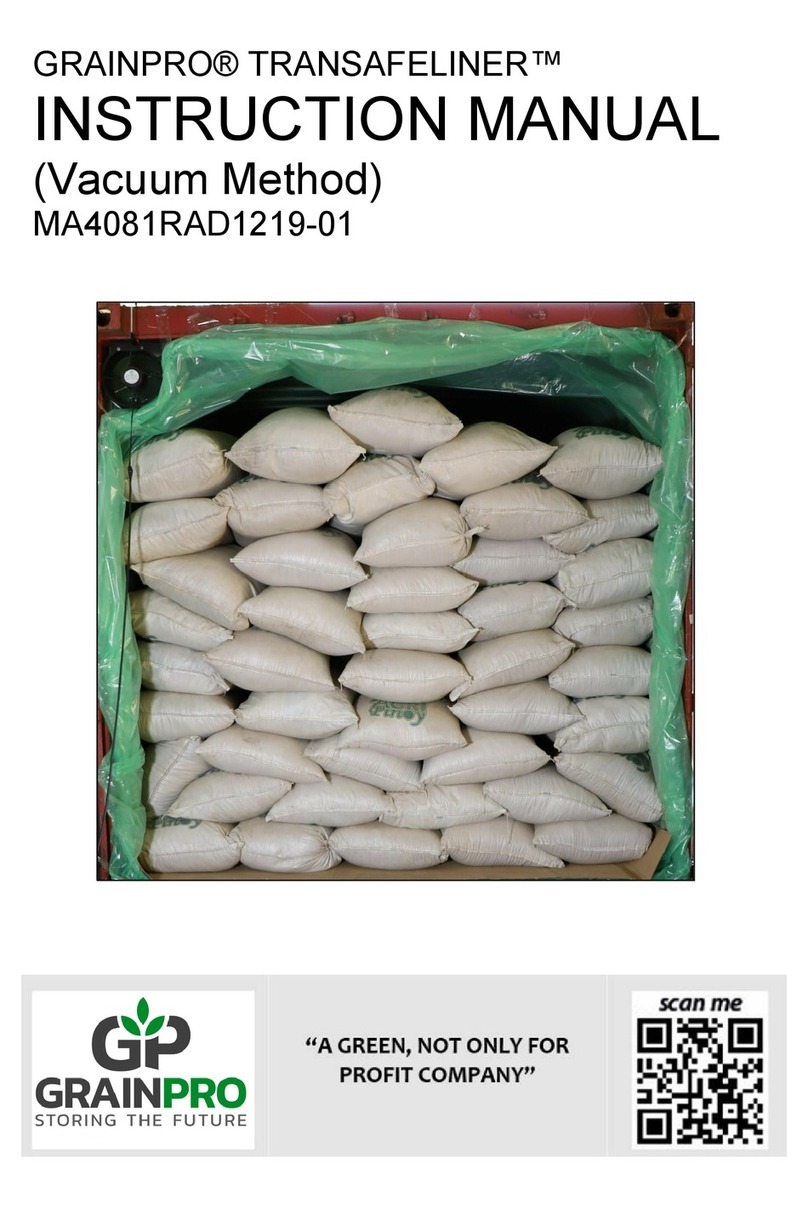
GrainPro
GrainPro TRANSAFELINER MA4081RAD1219-01 User manual

GrainPro
GrainPro TRANSAFELINER User manual

GrainPro
GrainPro TRANSAFELINER BULK User manual
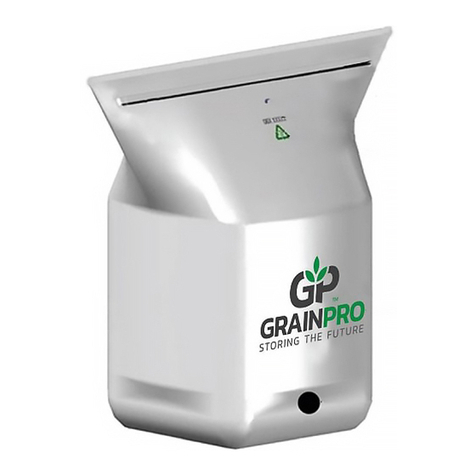
GrainPro
GrainPro GRAINSAFE 1.0/GHF User manual
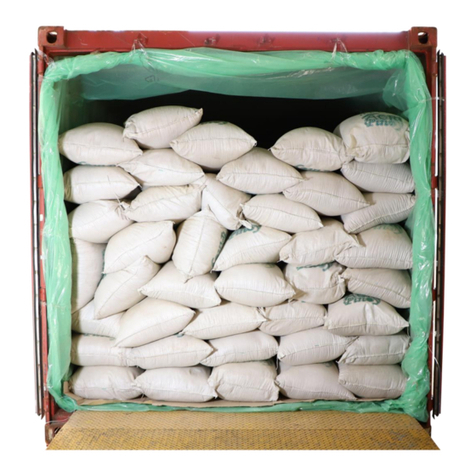
GrainPro
GrainPro TRANSAFELINER MA3001RR0208-21 User manual
Popular Farm Equipment manuals by other brands

Schaffert
Schaffert Rebounder Mounting instructions

Stocks AG
Stocks AG Fan Jet Pro Plus 65 Original Operating Manual and parts list

Cumberland
Cumberland Integra Feed-Link Installation and operation manual

BROWN
BROWN BDHP-1250 Owner's/operator's manual

Molon
Molon BCS operating instructions

Vaderstad
Vaderstad Rapid Series instructions











